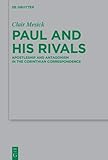Paul and his Rivals : Apostleship and Antagonism in the Corinthian Correspondence / Clair Mesick.
Material type: TextSeries: Beihefte zur Zeitschrift für die neutestamentliche Wissenschaft ; 271Publisher: Berlin ; Boston : De Gruyter, [2024]Copyright date: 2024Description: 1 online resource (XI, 303 p.)Content type:
TextSeries: Beihefte zur Zeitschrift für die neutestamentliche Wissenschaft ; 271Publisher: Berlin ; Boston : De Gruyter, [2024]Copyright date: 2024Description: 1 online resource (XI, 303 p.)Content type: - 9783111445175
- 9783111445458
- 9783111445441
- online - DeGruyter
- Issued also in print.
| Item type | Current library | Call number | URL | Status | Notes | Barcode | |
|---|---|---|---|---|---|---|---|
 eBook
eBook
|
Biblioteca "Angelicum" Pont. Univ. S.Tommaso d'Aquino Nuvola online | online - DeGruyter (Browse shelf(Opens below)) | Online access | Not for loan (Accesso limitato) | Accesso per gli utenti autorizzati / Access for authorized users | (dgr)9783111445441 |
Frontmatter -- Acknowledgments -- Contents -- Part One: The Rival Apostles at Corinth -- Chapter 1: A New Hypothesis on the Rivals of 2 Corinthians -- Chapter 2: The Rival Apostles in the History of Interpretation -- Chapter 3: Apostles, Teachers, and Rivals in the Corinthian Correspondence -- Part Two: Reading 1 Corinthians as the Root of the Conflict -- Chapter 4: Authority and Apostleship in the Corinthian Conflict -- Chapter 5: Financial Malpractice in the Corinthian Conflict -- Chapter 6: Jewish Identity in the Corinthian Conflict -- Conclusion -- Bibliography -- Subject Index -- Index of Ancient Sources
restricted access online access with authorization star
http://purl.org/coar/access_right/c_16ec
At the heart of Paul’s Corinthian correspondence is a historical puzzle. How did the relative calm of 1 Corinthians deteriorate into the chaos of 2 Corinthians, and what role did the so-called Jewish “super-apostles” play in that conflict? This book proposes a new solution: it was Paul, not his rivals, who shot the first volley in the Corinthian conflict. Paul’s claims of unique authority—for instance, as the architect atop whose foundation all others must build (1 Cor 3:10) and the Corinthians’ father while others are mere pedagogues (4:15)—would relegate other leaders to lesser positions. His contention that accepting financial support put an obstacle before the gospel (9:12) would jeopardize the livelihood of apostles who relied on such support. Finally, Paul’s claim that he becomes “lawless to the lawless” (9:21) or that “circumcision is nothing” (7:19) could throw into question Paul’s own Jewishness (cf. 2 Cor 11:22). By reading the Corinthian correspondence against the grain—imagining how Paul’s letter might have backfired for an audience who did not yet take him as scripture—this book explores how misunderstandings and misinterpretations can fracture church communities and cause a ripple effect of conflict and accusation.
Issued also in print.
Mode of access: Internet via World Wide Web.
In English.
Description based on online resource; title from PDF title page (publisher's Web site, viewed 20. Nov 2024)


